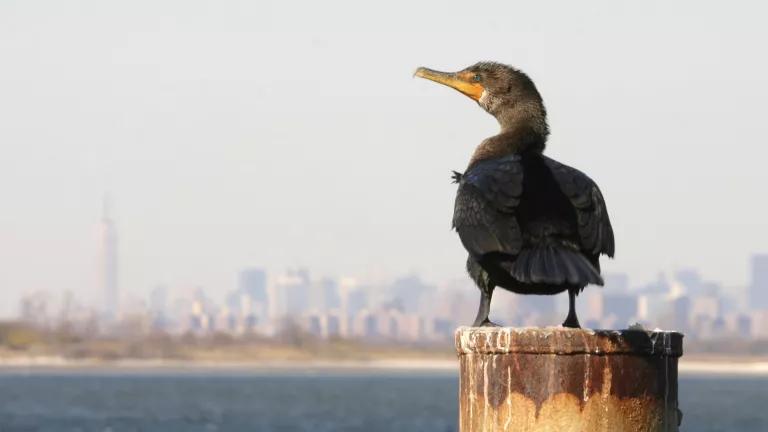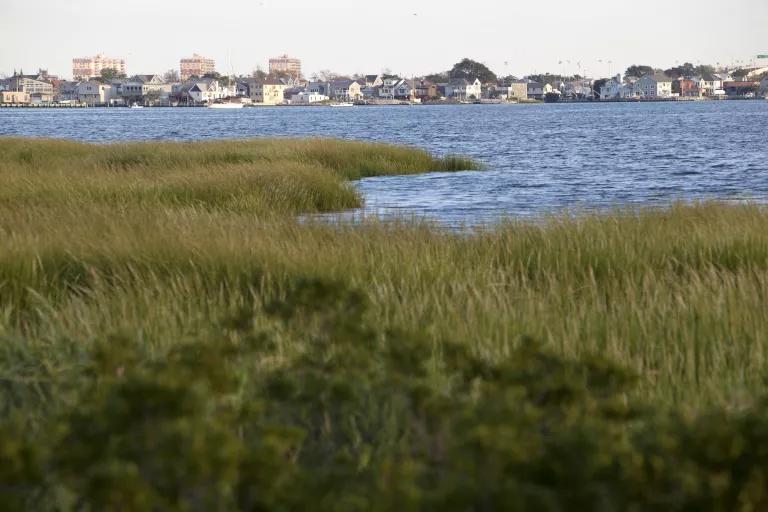The Battle for Jamaica Bay
Pollution was killing one of New York City’s greatest natural treasures—until NRDC stepped in.

Flying into John F. Kennedy International airport on a clear day can be stunning. Tall buildings dart up from Manhattan like densely packed needles. And the grandness of Central Park, a lush rectangle in the middle of the island, is awe inspiring.
But an equally magnificent view—though a much less highly rated one—comes just before the wheels touch down. If you’re landing from the southwest, you’ll see a beautiful array of untouched marshy islands scattered across the waters of Jamaica Bay. Nestled between the narrow Rockaway Peninsula and the meeting point of the boroughs of Brooklyn and Queens, Jamaica Bay is one of New York City’s last wild places. As NRDC attorney Larry Levine says, it’s “the crown jewel of the city’s green spaces.”
But its proximity to the Big Apple comes at a steep cost. Decades of pollution have devastated Jamaica Bay as well as the wildlife that seeks sanctuary there. After years of pressure from NRDC and its local partners, New York City and State finally agreed in 2011 to help restore and preserve the bay.
More than one third of these 39 square miles of waters and wetlands make up Jamaica Bay National Wildlife Refuge—the nation’s only wildlife refuge accessible by subway. Every year, millions flock to enjoy outdoor activities like camping and boating. The refuge, which lies along a major migration route called the Atlantic Flyway, also has a long-standing reputation for being a birder’s paradise. It serves as a pit stop for about 20 percent of North America’s bird species, and roughly 70 species—including egrets, ospreys, hawks, peregrine falcons, and barn owls—nest regularly there.
Jamaica Bay is also home to more than 100 species of fish, mollusks, crustaceans, diamondback terrapins, and the critically endangered Kemp’s ridley sea turtle. But below the water’s surface, a lack of oxygen has been choking this aquatic life for decades. The main culprits? Four nearby sewage treatments that were collectively dumping 250 million gallons of partially treated wastewater into the bay every single day. That kind of discharge may be free of bacteria, but it’s high in nitrogen, an organic pollutant that creates harmful algae blooms. The blooms turned the water murky and caused oxygen levels to plummet, making areas of the bay inhospitable to marine life and unusable to people.
Jamaica Bay’s salt marshes have also eroded at an alarming rate, due in part to the nitrogen pollution. (Rising sea level brought on by climate change is also to blame.) Those marshes are critical; along with providing habitat, they act as flood protection and filter out contaminants—like overflows of raw sewage and polluted stormwater.

The 2011 cleanup agreement came after NRDC—along with local advocacy groups Jamaica Bay Ecowatchers, the American Littoral Society, and NY/NJ Baykeeper—threatened to sue New York City in 2009 for violating the Clean Water Act. It targeted the two biggest threats: water pollution and disappearing islands. And it included three specific remedies: upgrading the four sewage-treatment plants, restoring the bay’s threatened marshes, and establishing enforceable limits on nitrogen pollution.
Once completed in 2020, the city’s $187 million in improvements to its sewage-treatment plants will cut the nitrogen flow into Jamaica Bay to an average of 20,000 pounds per day, just half the pre-agreement amount. But even before completion, the improvements have begun making a big difference. Within just a few years, the amount of nitrogen pouring into the bay’s waters daily had dropped by at least a quarter. And Jamaica Bay Ecowatchers president Dan Mundy Jr., a lifelong bay-area resident and an avid boater and diver, reported in 2014 that he was already seeing far fewer algae blooms and much clearer water.
Meanwhile, the $15 million that New York City committed to restore Jamaica Bay’s disappearing marshes—plus some federal funds—is steadily improving the health of the bay through the planting of hundreds of thousands of new wetlands plants.
Finally, the settlement resolved long-standing disputes over New York State’s Clean Water Act permits. They now lock in strong nitrogen pollution limits and, importantly, allow citizen groups like Ecowatchers to enforce any violations.
Thanks to relentless advocacy and encouraging cooperation, the area now has a new lease on life. It will remain a sanctuary for wildlife—and for millions of New Yorkers. “It shows the power of a coalition that includes local activists as well as NRDC to create change in the New York City environment,” NRDC attorney Brad Sewell says. “It has created a new hope for what Jamaica Bay can be. Even in a degraded state, it’s a world-class birding destination. Imagine what it will be when it’s fully restored.”
This NRDC.org story is available for online republication by news media outlets or nonprofits under these conditions: The writer(s) must be credited with a byline; you must note prominently that the story was originally published by NRDC.org and link to the original; the story cannot be edited (beyond simple things such as grammar); you can’t resell the story in any form or grant republishing rights to other outlets; you can’t republish our material wholesale or automatically—you need to select stories individually; you can’t republish the photos or graphics on our site without specific permission; you should drop us a note to let us know when you’ve used one of our stories.


New York Is Exposing the Fashion Industry for What It Is: a Climate Nightmare
When It Rains, It Pours Raw Sewage into New York City’s Waterways
After Decades, Tenants Are Still Fighting NYC Public Housing for Speedy Mold Relief